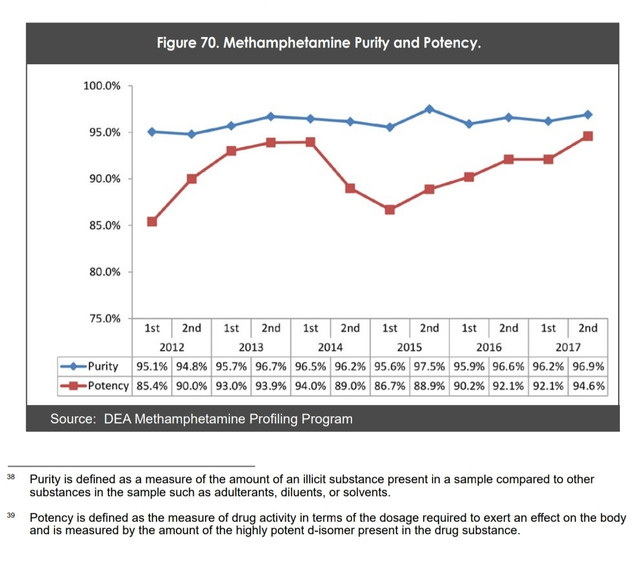Shifts in manufacture of methamphetamine have continued in North America
Improved precursor control (including with the Chemical Diversion and Trafficking Act of 1988, the Domestic Chemical Diversion and Control Act of 1993 and in particular the Combat Methamphetamine Epidemic Act of 2005) regulating over-the-counter sales of methamphetamine precursor chemicals such as ephedrine preparations and pseudoephedrine, and ongoing efforts to dismantle laboratories seem to have acted as a deterrent to large-scale domestic methamphetamine manufacture in the United States over the last 15 years. This approach seemed to have worked well initially, as domestic groups involved in methamphetamine manufacture in the United States (largely dominated by motorcycle gangs at the time) had limited chemical skills and were not in a position to seek alternative methods of manufacture, helping to reduce the domestic market for methamphetamine in the first decade of the new millennium. Annual prevalence of methamphetamine use fell from 0.7 per cent of the population aged 12 and older in 2002 to 0.3 per cent in 2008.5 Nonetheless, since 2010, the decrease in the domestic manufacture of methamphetamine in the United States has been more than offset by increasing imports of the drug from Mexico. A number of indicators have pointed to an expansion of the methamphetamine market within the United States, both in terms of supply of (sharply rising amounts seized and falling purity-adjusted prices) and demand for (rising prevalence of use, positive tests among the general workforce, treatment admissions and deaths) the drug.
The introduction of similar legislation in Mexico in 2008 to prevent over-the-counter sales and the diversion of ephedrine preparations and pseudoephedrine for the manufacture of methamphetamine, however, has not had the same impact as in the United States; instead, it has prompted Mexican organized crime groups to switch from using the ephedrine or pseudoephedrine method to the P-2-P-based method in the manufacture of methamphetamine. Initially, this went in parallel with the manufacture of a poorer quality product, but as the use of the P-2-P method in the methamphetamine found on the United States markets increased (rising from 1 per cent in 2007 to 37 per cent in the fourth quarter of 2009), the overall potency of methamphetamine found on the United States market declined, from 96 per cent in 2007 to 64 per cent in 2009. Without further purification at that time, the use of P-2-P allowed only for the manufacture of a less potent methamphetamine-racemate instead of the more potent d-methamphetamine that could be manufactured from ephedrine or pseudoephedrine.
Manufacturers tried to compensate for this apparent shortcoming by increasing the purity of methamphetamine: the purity of the methamphetamine found on the United States market rose from about 40 per cent in 2007 to close to 70 per cent in 2009.
According to United States authorities, the chemical expertise of Mexican organized crime groups improved further and they eventually succeeded in manufacturing highly potent d-methamphetamine from P-2-P, a skill that is now also sought after by criminal groups in countries outside the Americas. The reported purity of methamphetamine in the United States rose from 92 per cent in the first half of 20118 to 97 per cent in the first quarter of 2019, while the potency of the drug rose from 76 per cents to almost 98 per cent over the same period. This indicates an improvement in the know-how of the organized crime groups and an overall increase in the supply of methamphetamine in the United States.° The analysis of seizure data also suggests that, by the first half of 2019, 99 per cent of the methamphetamine on the United States market was manufactured using the P-2-P-based method, mainly out of non-controlled precursors of P-2-P, typically imported from China.

